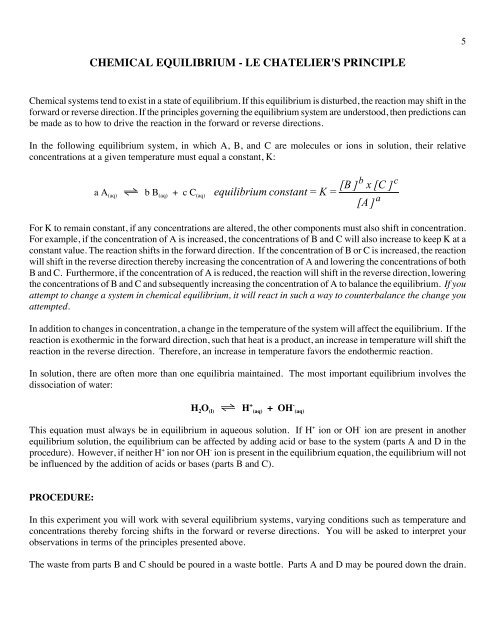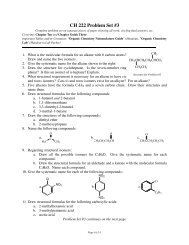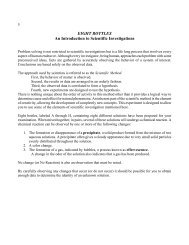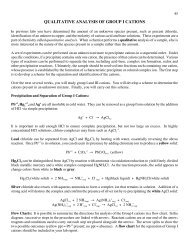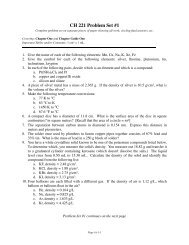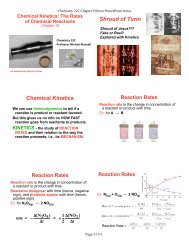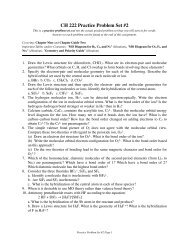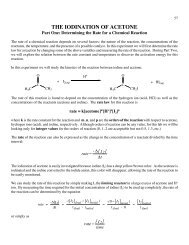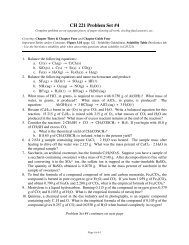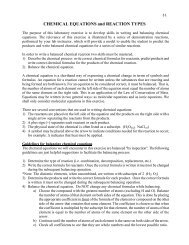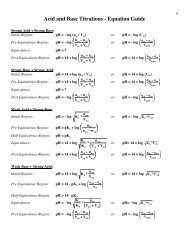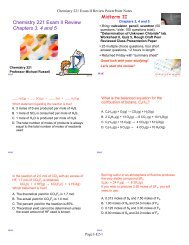Le Chatelier's Principle
Le Chatelier's Principle
Le Chatelier's Principle
- No tags were found...
You also want an ePaper? Increase the reach of your titles
YUMPU automatically turns print PDFs into web optimized ePapers that Google loves.
5CHEMICAL EQUILIBRIUM - LE CHATELIER'S PRINCIPLEChemical systems tend to exist in a state of equilibrium. If this equilibrium is disturbed, the reaction may shift in theforward or reverse direction. If the principles governing the equilibrium system are understood, then predictions canbe made as to how to drive the reaction in the forward or reverse directions.In the following equilibrium system, in which A, B, and C are molecules or ions in solution, their relativeconcentrations at a given temperature must equal a constant, K:[B ]equilibrium constant = K =x [C ]a A (aq) qe b B (aq) + c C (aq)[Aa]For K to remain constant, if any concentrations are altered, the other components must also shift in concentration.For example, if the concentration of A is increased, the concentrations of B and C will also increase to keep K at aconstant value. The reaction shifts in the forward direction. If the concentration of B or C is increased, the reactionwill shift in the reverse direction thereby increasing the concentration of A and lowering the concentrations of bothB and C. Furthermore, if the concentration of A is reduced, the reaction will shift in the reverse direction, loweringthe concentrations of B and C and subsequently increasing the concentration of A to balance the equilibrium. If youattempt to change a system in chemical equilibrium, it will react in such a way to counterbalance the change youattempted.In addition to changes in concentration, a change in the temperature of the system will affect the equilibrium. If thereaction is exothermic in the forward direction, such that heat is a product, an increase in temperature will shift thereaction in the reverse direction. Therefore, an increase in temperature favors the endothermic reaction.In solution, there are often more than one equilibria maintained. The most important equilibrium involves thedissociation of water:bcH 2 O (l) qe H + (aq) + OH - (aq)This equation must always be in equilibrium in aqueous solution. If H + ion or OH - ion are present in anotherequilibrium solution, the equilibrium can be affected by adding acid or base to the system (parts A and D in theprocedure). However, if neither H + ion nor OH - ion is present in the equilibrium equation, the equilibrium will notbe influenced by the addition of acids or bases (parts B and C).PROCEDURE:In this experiment you will work with several equilibrium systems, varying conditions such as temperature andconcentrations thereby forcing shifts in the forward or reverse directions. You will be asked to interpret yourobservations in terms of the principles presented above.The waste from parts B and C should be poured in a waste bottle. Parts A and D may be poured down the drain.
6PROCEDURE: Part A: Solubility Equilibrium: Finding a value for K spMany ionic compounds have limited water solubility, dissolving only partially in water. An example is PbCl 2 :PbCl 2(s) qe Pb +2 (aq) + 2 Cl - (aq) K sp = [Pb +2 ][Cl - ] 2The concentration of PbCl 2 does not enter into the equilibrium equation because it is a solid and therefore has aconstant effect on the system, independent of its amount. The equilibrium constant for a solubility equilibrium iscalled the solubility product constant and symbolized as K sp . For this equilibrium to exist, there must be somesolid PbCl 2 present in the system. If there is no solid present, there is no equilibrium.1. Set up a hot water bath using a 400 mL beaker. To a test tube, add 5.0 mL 0.30 M Pb(NO 3 ) 2 . Add 0.30 M HClin 0.5 mL increments (10 drops) to the Pb(NO 3 ) 2 until a white precipitate forms.a. Record the volume of HCl needed and determine the moles of Cl - present in your solution.b. Determine the moles of Pb +2 ion present in the final solution.c. Calculate K sp . (Note: You must use diluted concentrations of ions in mol/L)d. Why did the PbCl 2 not precipitate immediately on addition of HCl?2. Observing the effect of temperature on the system can determine the sign of enthalpy for this reaction.a. Place the test tube in hot water and record your observations.b. Place the test tube in cold water and record your observations.c. What is the sign of ΔH for the above reaction? Explain.d. What happened to the value of K sp in the hot solution? (Increase, decrease, no change) Explain.3. Add distilled water to the test tube in 0.5 mL increments, stirring well after each addition.a. Record the volume of water added when the precipitate just dissolves.b. Calculate the molar concentration of Pb +2 and Cl -1 ions and your reactant quotient (Q).c. Explain why the PbCl 2 dissolved in water.Part B: Complex Ion EquilibriaMany metallic ions exist as complex ions in solution, combining with other ions or molecules called ligands. Whilecomplex ions are stable, they may be converted to other complex ions by the addition of ligands that form morestable complexes. Common ligands that form complex species include OH - , NH 3 , and Cl - , among others. Forexample, in solution the cobalt (II) ion can exist as either the pink complex ion Co(H 2 O) 6+2(aq) or the blue complexion CoCl 4-2(aq) depending on the conditions of the solution. The principles of equilibrium can be used to predictwhich ion will be present.Co(H 2 O) 6+2(aq) (pink) + 4 Cl - (aq) qe CoCl 4-2(aq) (blue) + 6 H 2 O1. Place a few small crystals of CoCl 2 - 6 H 2 O in a regular test tube. Record the color and determine the Co(II)complex ion present in solution for each of the following. Explain.a. Add 2 mL (40 drops) of 12 M HCl (CAUTION) and stir to dissolve the crystals.b. Add 2 mL increments of distilled H 2 O to the test tube until no further color change occurs.c. Place the sample in hot water and cold water and record the color change. What is the sign of ΔH for the aboveequation? Explain.
7Part C: Acid-Base IndicatorsAcid-base indicators are chemical substances which change color in solution when [H + ] changes. Methyl violet(HMV) is an example of an acid-base indicator. In solution, HMV dissociates as follows:HMV (aq) (yellow) qe H + (aq) + MV - (aq) (violet)In solution, HMV has an intense yellow color while MV - is violet. Therefore, a change in [H + ] will affect the colorof the indicator solution.1. Add 5 mL of distilled H 2 O to a test tube. Add a few drops of methyl violet indicator. Record the color.2. What reagent could be added to shift the equilibrium (change color)? Design and test your hypothesis todemonstrate this equilibrium shift. Explain your results.3. What reagent could be added to shift the equilibrium back to its original color? Design and test thishypothesis. Explain your results.Part D: Dissolving Insoluble SolidsNot all solids will dissolve by adding more water or heating the solution. However, in these cases we can employthe principles of equilibrium to dissolve solids. We will use Zn(OH) 2 as an example:Zn(OH) 2(s) qe Zn +2 (aq) + 2 OH - (aq) where K sp = [Zn +2 ] x [OH - ] 2 = 5 x 10 -17The equilibrium constant for this dissociation is quite small, indicating that the reaction does not go very far to theright. Thus, Zn(OH) 2 is virtually insoluble in water. In a saturated solution, [Zn +2 ] x [OH - ] 2 must equal 5 x 10 -17 .However, if this product is somehow lowered to less than 5 x 10 -17 , then Zn(OH) 2 will dissolve until the productsequal K sp , where equilibrium will again be obtained. To do this, the concentration of one of the products must belowered rather drastically. Using a second equilibrium present in solution:H + (aq) + OH - (aq) qe H 2 O (l)the addition of an acid to the solution will increase [H + ] and thereby lower [OH - ]. This in turn will drive the abovereaction to the right, dissolving Zn(OH) 2 .Alternatively, we can lower the concentration of Zn +2 ion by taking advantage of the fact that zinc ion forms stablecomplex ions with OH - and NH 3 :Zn +2 (aq) + 4 OH - -2(aq) qe Zn(OH) 4 (aq), K 1 = 3 x 10 15Zn +2 +2(aq) + 4 NH 3(aq) qe Zn(NH 3 ) 4 (aq), K 2 = 1 x 10 9In high concentrations of OH - or NH 3 , the above reactions are driven to the right, lowering [Zn +2 ].1. To each of three small test tubes, add about 2 mL 0.1 M Zn(NO 3 ) 2 . Add one drop 6M NaOH to each test tubeand stir. Record your observations.a. To the first test tube add 6 M HCl drop by drop. Record and explain your observations.b. To the second test tube add 6 M NaOH drop by drop. Stir well and explain your observations.c. To the third test tube add 6 M NH 3 (or NH 4 OH) drop by drop. Stir well and explain your observations.
82. Repeat the above procedure using 2 mL of 0.1 M Mg(NO 3 ) 2 instead of Zn(NO 3 ) 2 in three separate test tubes.Add one drop of 6 M NaOH to each test tube and stir. Record your observations.a. Use the same volume of HCl as you used with the Zn(NO 3 ) 2 , above, and stir well. Record yourobservations.b. Use the same volume of 6 M NaOH as you used with the Zn(NO 3 ) 2 , above, and stir well. Record yourobservations.c. Use the same volume of 6 M NH 3 (or NH 4 OH) as you used with the Zn(NO 3 ) 2 , above, and stir well. Recordyour observations.3. Explain the following in your report:a. What insoluble hydroxide formed when one drop of NaOH was added to the Zn(NO 3 ) 2 ? To the Mg(NO 3 ) 2 ?b. Explain why some of the reactions were similar between the two metal ions and why some were different.c. Why does an insoluble hydroxide tend to dissolve in acidic solution?d. Does Mg +2 ion appear to form complex ions with OH - and NH 3 ? Explain.POSTLAB QUESTIONS:1. Methyl orange (HMO) is a common acid-base indicator. In solution it ionizes according to the equation:HMO (red) qe H ++ MO - (yellow)Chat adds 5 mL of distilled water to a test tube and adds 5 drops of methyl orange. He is captivated by thelovely yellow color of the solution.a. If Chat adds 6 M HCl to his solution, what color will he observe? Explain.b. If Chat next adds 6 M NaOH to the solution, what color will be observe? Explain.2. Zinc hydroxide is relatively insoluble in water. The reaction is represented as:Zn(OH) 2(s) qe Zn +2 (aq) + 2 OH - (aq)a. What is the equilibrium expression for the above reaction?b. For Zn(OH) 2 to be soluble in solution, [Zn +2 ] or [OH - ] must be relatively small. Explain.c. Would you expect Zn(OH) 2 to dissolve if acid were added to the solution? Explain.3. How might <strong>Le</strong> <strong>Chatelier's</strong> <strong>Principle</strong> assist chemists working in an industrial setting? Explain.


